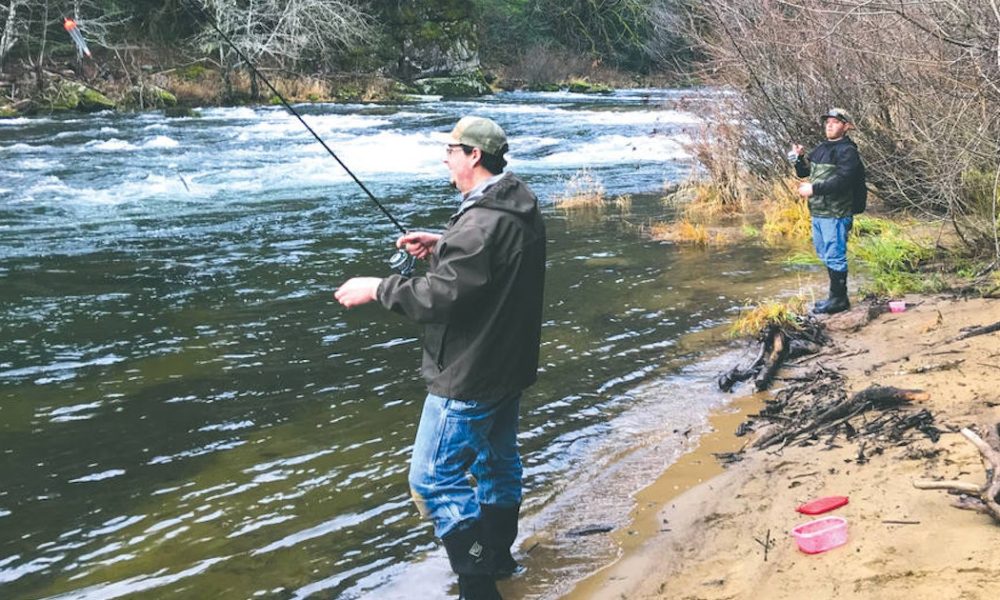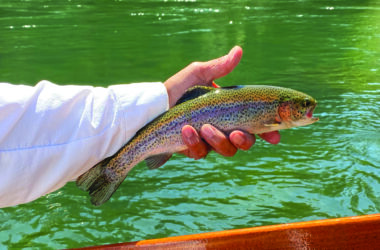 I shared a stretch of riverbank along Lake Creek last weekend with Justin Ellis and his buddy Sam, both from Junction City. It was a slow morning for us all, but more steelhead are on the way. The peak of the annual mid-coast runs comes in late February. Frank Armendariz/For The Chronicle
I shared a stretch of riverbank along Lake Creek last weekend with Justin Ellis and his buddy Sam, both from Junction City. It was a slow morning for us all, but more steelhead are on the way. The peak of the annual mid-coast runs comes in late February. Frank Armendariz/For The Chronicle
At the top of this week’s report, in the spirit of the holiday season, are a gesture of goodwill and wishes of happy tidings from my wife Tami and myself to all the readership, advertisers and other supporters of The Chronicle. For anyone who writes it is a blessing to be read, so please accept my humble seasonal wishes in return….
After last week’s fairly decent soaking, winter steelhead, like the ghosts they are, appeared in the lower reaches of rivers all up and down the Oregon coast. It’s just the very tip of the run but for the next three months after each storm, and into early spring, a small wave of winter steelhead will float in with every high tide, quickly pass through the estuary and settle into the river.
Unlike salmon that rush upriver in large schools, steelhead are far less frantic and come in small pods that often disperse in the river. These early runs, December to February are mostly hatchery steelhead that you can keep and can be identified by a clipped and healed over adipose fin.
Wild steelhead will also be in the mix but larger numbers come home from late winter into April and early May, but the early winter steelhead will mostly be keepers.
Adding to the good news, the fall drought that was so pervasive appears to have broken. In the next few days, many coastal rivers will rise sharply, bringing more steelhead. Heading toward New Year’s Day, things are shaping up nicely as a Christmas gift – a chance to get a little more use out of that expiring fishing license and put a couple of winter steelhead on that 2019 tag.
Unlike the rivers on the northern Oregon coast that have seen extremely low flows, troubling salmon die-offs and closures this fall, the central coast stems, including the Siletz, Alsea, Siuslaw and Lake Creek were under the modest fall storm track and fortunately for local anglers were the beneficiaries of the few fall rainstorms we did have. ”A leg up” central coast rivers are in excellent condition as we head into the meat of the winter steelhead season.
All the hatchery winter steelhead released in the central coast rivers are raised at the North Fork of the Alsea River Fish Hatchery in Alsea. They are all fin-clipped, the offspring of hatchery adults, collected from each individual river.
The hatchery-reared steelhead are then reintroduced as smolts to their home river, where they ”imprint” to return again in a couple of years to the same location in the same river as adults. On the Siletz, Alsea and on Lake Creek the ODFW employs a ”planting strategy” to better spread the fish throughout the river, so they don’t just make a beeline and all stack up where they were planted.
The Siletz and Alsea also have a broodstock program, where one of the spawning adults is a wild, unclipped fish. The offspring are also raised in the hatchery but broodstock steelhead tend to grow larger, maintain their wild aggressiveness and bite much better. They are also fin-clipped before being released to the river and are prized keepers.
On the Siletz, winter steelhead smolts are released to imprint at Hee Hee Illahee Landing, at the top of the ”town run” at Twin Bridges Landing and at Moonshine Park – a very popular bank-fishing stretch.
On the Alsea, smolts are released directly from the North Fork Hatchery, at Salmon Berry and at Five Rivers. On Lake Creek the fish go in at Deadwood and Indian Creek. On the Siuslaw, with less strategy, a small number of steelhead smolts are released in the far upper Siuslaw drainage in the Lorane Valley at Letz Creek, a STEP (Salmon and Trout Enhancement Program) facility run by members of the Steelheader Association. The largest portion, about 80%, are all released at Whittaker Creek, which is also where you will find the largest concentration of other steelheaders on the Siuslaw River.
Imprinting causes the fish to linger where they were planted. Although many returning adult steelhead will stray further upriver, the strategy makes more fish available to more anglers through a long section of each river and through a larger portion of the season. It also minimizes crowding, spreading anglers, like the fish, through a larger part of each river where imprinting is done.
There are plenty of instructional videos online with specific information about winter steelhead fishing and steelheading techniques – in fact, it can be a little overwhelming because there is so much. I always tell folks to pick one or two different approaches – the simplest are the best – and learn everything you can about that specific technique. I will tell you that ”bobber fishing” has become popular and most winter steelheaders’ technique of choice for a reason. It’s simple but very effective and it won’t cost you much to get you in the game.
Steelhead can appear elusive, and they are at times. Often solitary or in pairs, they migrate in small numbers, which adds to the mystique but when enticed they are quick to strike – much more so than salmon in the river. If you aren’t getting bites, you likely just need to move to another spot and be as mobile as the fish.
Now go fishing; take your kids or a friend. Those will become some of the best memories of you life.
You can reach Frank by visiting rivertrailoutfitters.com.








